
Животные цветными карандашами
.pdf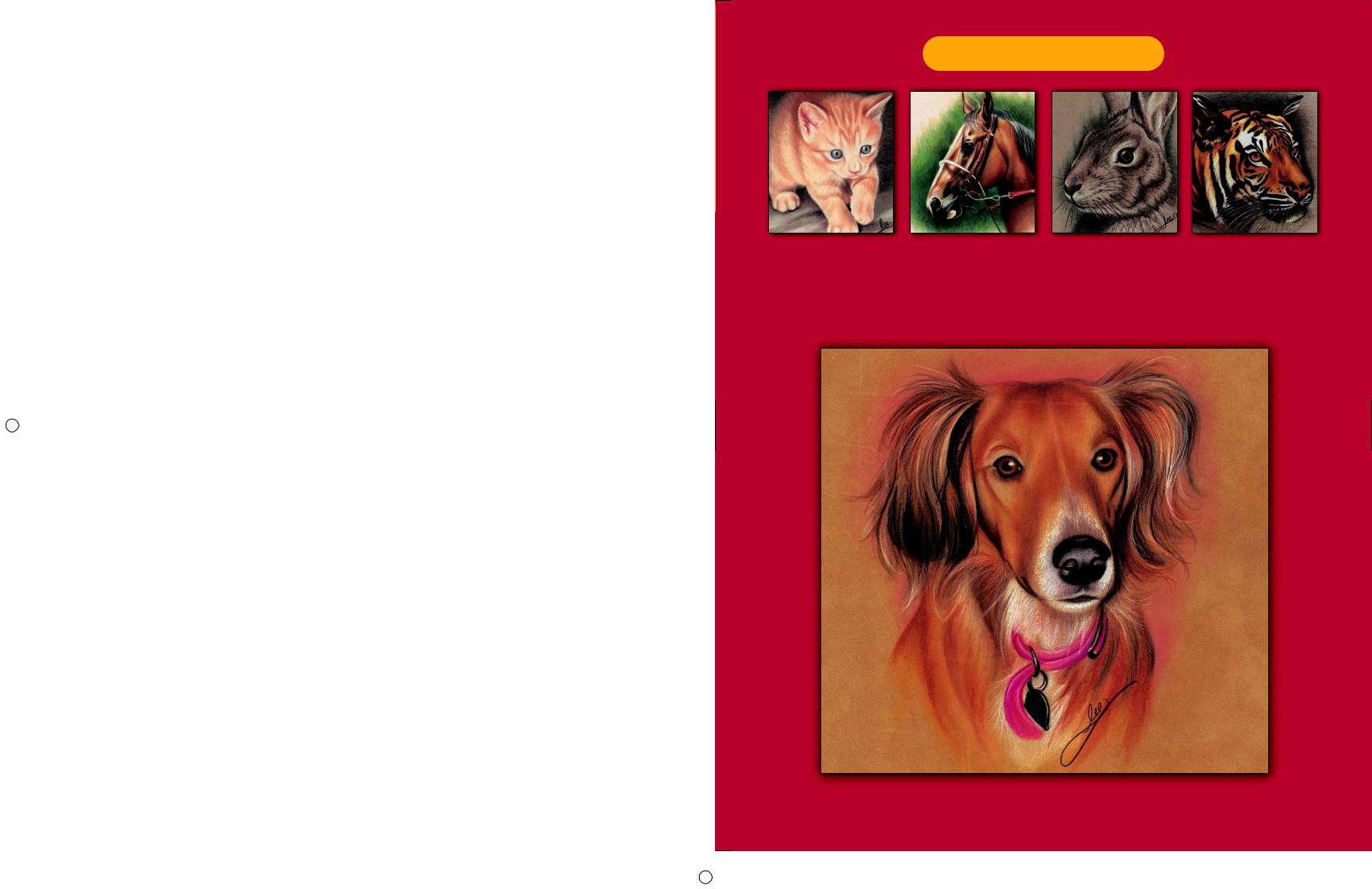
Drawing in Color
ANIMALS
Lee Hammond

Drawing in Color
ANIMALS
Lee Hammond
NORTH LIGHT BOOKS
CINCINNATI, OHIO
www.artistsnetwork.com

About the Author
Polly “Lee” Hammond is an illustrator and art instructor from the Kansas City area. She owns and operates a private art studio named Take It To Art*, where she teaches realistic drawing and painting.
Lee was raised and educated in Lincoln, Nebraska, and established her career in illustration and teaching in Kansas City. Although she has lived all over the country, she will always consider Kansas City home.
Lee has been an author with North Light Books since 1994. She also writes and illustrates articles for other publications, such as The Artist’s Magazine.
Lee is continuing to develop new art instruction books for North Light and is also expanding her career into illustrating children’s books. Fine art and limited edition prints of her work will also soon be offered.
Lee resides in Overland Park, Kansas, along with her family.
Note: You may contact Lee via e-mail at Pollylee@aol.com or visit her Web site at http://LeeHammond.com.
*Take It To Art is a registered trademark for Lee Hammond.
Drawing in Color: Animals. Copyright © 2002 by Polly “Lee” Hammond. Manufactured in China. All rights reserved. No part of this book may be reproduced in any form or by any electronic or mechanical means including information storage and retrieval systems without permission in writing from the publisher, except by a reviewer who may quote brief passages in a review. Published by North Light Books, an imprint of F&W Publications, Inc., 4700 East Galbraith Road, Cincinnati, Ohio 45236. (800) 289-0963. First edition.
Other fine North Light Books are available from your local bookstore, art supply store or direct from the publisher.
06 05 04 03 |
5 |
4 3 |
2 |
Library of Congress Cataloging-in-Publication Data
Hammond, Lee 1957-
Drawing in color: animals / Lee Hammond. p. cm.
Includes index.
ISBN 1-58180-273-0 (alk. paper)
ISBN-13: 978-1-60061-501-6 (EPUB)
[1. Animals in art. 2. Drawing--Technique.] I. Title.
NC780 .H243 2002 |
|
743.6--dc21 |
2001059643 |
Editor: Bethe Ferguson
Production Coordinator: John Peavler
Cover Designer: Wendy Dunning
METRIC CONVERSION CHART |
|
|
to convert |
to |
multiply by |
Inches |
Centimeters |
2.54 |
Centimeters |
Inches |
0.4 |
Feet |
Centimeters |
30.5 |
Centimeters |
Feet |
0.03 |
Yards |
Meters |
0.9 |
Meters |
Yards |
1.1 |
Sq. Inches |
Sq. Centimeters |
6.45 |
Sq. Centimeters |
Sq. Inches |
0.16 |
Sq. Feet |
Sq. Meters |
0.09 |
Sq. Meters |
Sq. Feet |
10.8 |
Sq. Yards |
Sq. Meters |
0.8 |
Sq. Meters |
Sq. Yards |
1.2 |
Pounds |
Kilograms |
0.45 |
Kilograms |
Pounds |
2.2 |
Ounces |
Grams |
28.3 |
Grams |
Ounces |
0.035 |
|
|
|
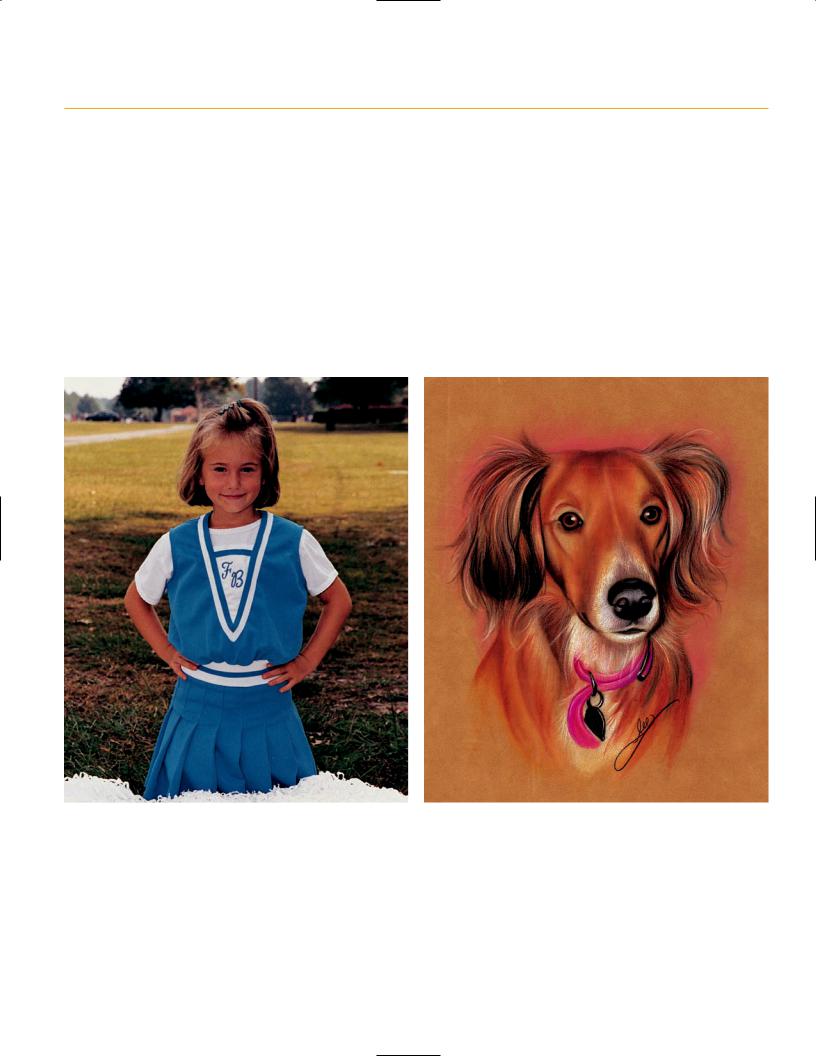
Dedication and Acknowledgements
This book is dedicated to my granddaughter Taylor Marie. I hope you continue to love animals and art as much as I do. Thanks for being such a fun little girl and adding so much joy to my life! I love you!
—Grama Lee
I would also like to dedicate this book to my guardian angel, Penny. Thanks for watching over me and keeping me from harm.
Of all the accomplishments in my life, writing for North Light Books has been one of the most rewarding. My books have opened up an entire world of friendships for me. How lucky we are to live in this day and age, where we have the technology available to communicate across the globe.
I want to thank my readers, wherever you may reside, for supporting
my artistic goals. Your warm thoughts and well wishes are gratefully received and appreciated. I wish each and every one of you the very best life has to offer.
A special thank you to everyone at North Light Books for making this dream possible!
Taylor Marie |
P E N N Y |
Age 6 |
Prismacolor pencils on no. 7184 Cinnamon suede board |
14" x 11" (36cm x 28cm)

Table of Contents
C H A P T E R O N E |
|
C H A P T E R E I G H T |
You Can Do It! |
5 |
Hair and Fur 43 |
C H A P T E R T W O |
|
C H A P T E R N I N E |
Getting Started |
7 |
Verithin Pencils 53 |
C H A P T E R T H R E E |
|
C H A P T E R T E N |
The Different “Looks” |
Prismacolor Pencils 57 |
|
of Colored Pencil 12 |
|
|
C H A P T E R F O U R |
|
C H A P T E R E L E V E N |
Technique 15 |
|
Studio Pencils 61 |
C H A P T E R F I V E |
|
C H A P T E R T W E LV E |
Basic Shapes |
|
Colored Pencils |
and Shading 17 |
|
on Suede 66 |
C H A P T E R S I X |
|
C H A P T E R T H I R T E E N |
Graphing 24 |
|
Other Options 76 |
C H A P T E R S E V E N
Drawing Animal Features
in Prismacolor 30
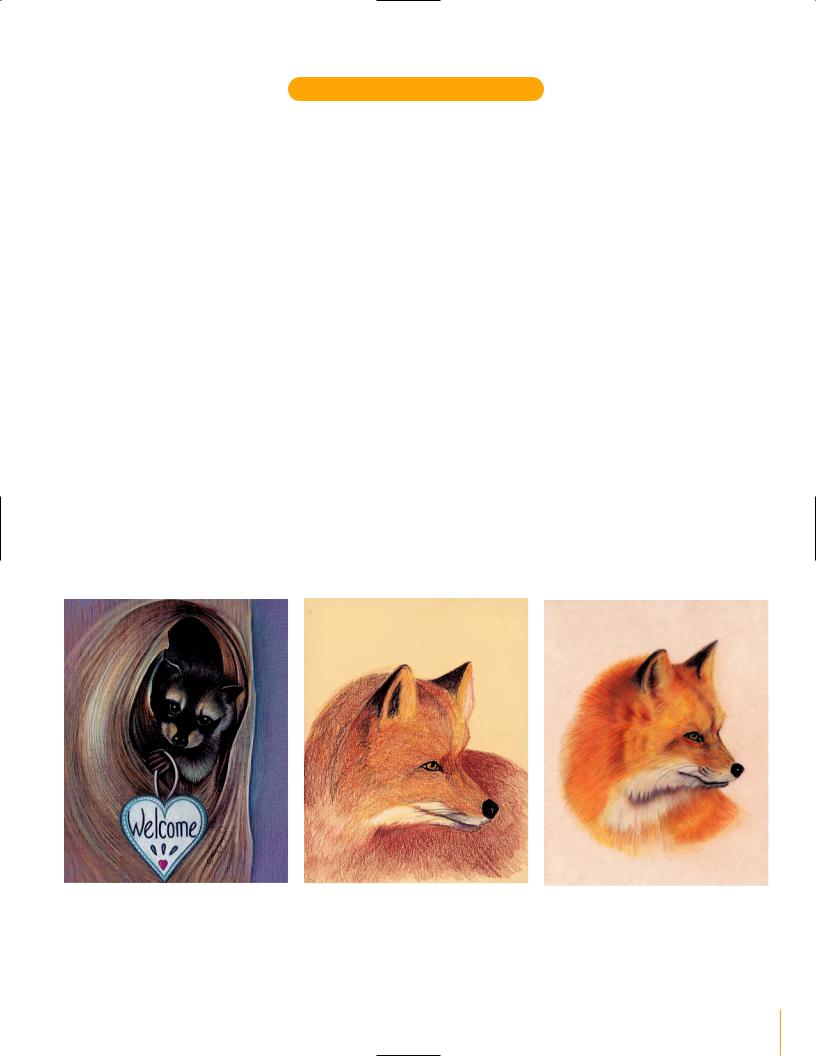
C h a p t e r O n e
You Can Do It!
Colored pencil can be a very frustrating and confusing medium. As an art instructor, I see many students struggling in the beginning to learn the various techniques.
As with anything else in life, it just takes some understanding and a lot of practice to become comfortable with something new.
I tell my students to relax when they first begin. Not all artistic attempts need to be wonderful pieces of art which are suitable for framing. Rarely do our first attempts create the results we are striving for. You must not be afraid to experiment.
I’ve been a professional artist for many years. However, I still struggle
at times and throw away projects that just plain do not work out. It’s okay. Struggling and experimenting are part of the process and should not be seen as failures. Experiments are just as important as the final pieces. Learn to embrace them both!
I always remind the beginner that I too was a beginner and was once in their shoes. I honestly didn’t like colored pencils when I first began working with them. I was too conditioned as a child to use pencils to just “fill in” color. The process of layering colors, or blending colors, escaped me at first. My projects resembled crayon drawings, and I blamed myself for my lack of talent. However, years
later—when I matured artistically—I figured out my problem. I approached drawing with colored pencil differently and learned to love it.
Unfortunately, back when I was beginning, few books were written on colored pencil. I was forced to learn through trial and error. You now have a wonderful selection of books available by extremely gifted artists. Everything you need to know is at your fingertips. All you really need to do is practice.
Look at the example below. It is the progress of a typical art student. Your progress may appear very similar.
Welcome to the wonderful world of colored |
DRAWING BY A STUDENT, LAURA TIEDT |
pencil! |
The first attempt is not necessarily a bad |
|
drawing. You can see how the student was |
|
hesitant about applying the colored pencil. In |
|
the end, the drawing looked incomplete. |
ATTEMPT TWO BY LAURA TIEDT
This second attempt looks much more realistic. The student used layers of color and a heavier application with the pencils, which gave the drawing more depth and realism.
You Can Do It! |
5 |
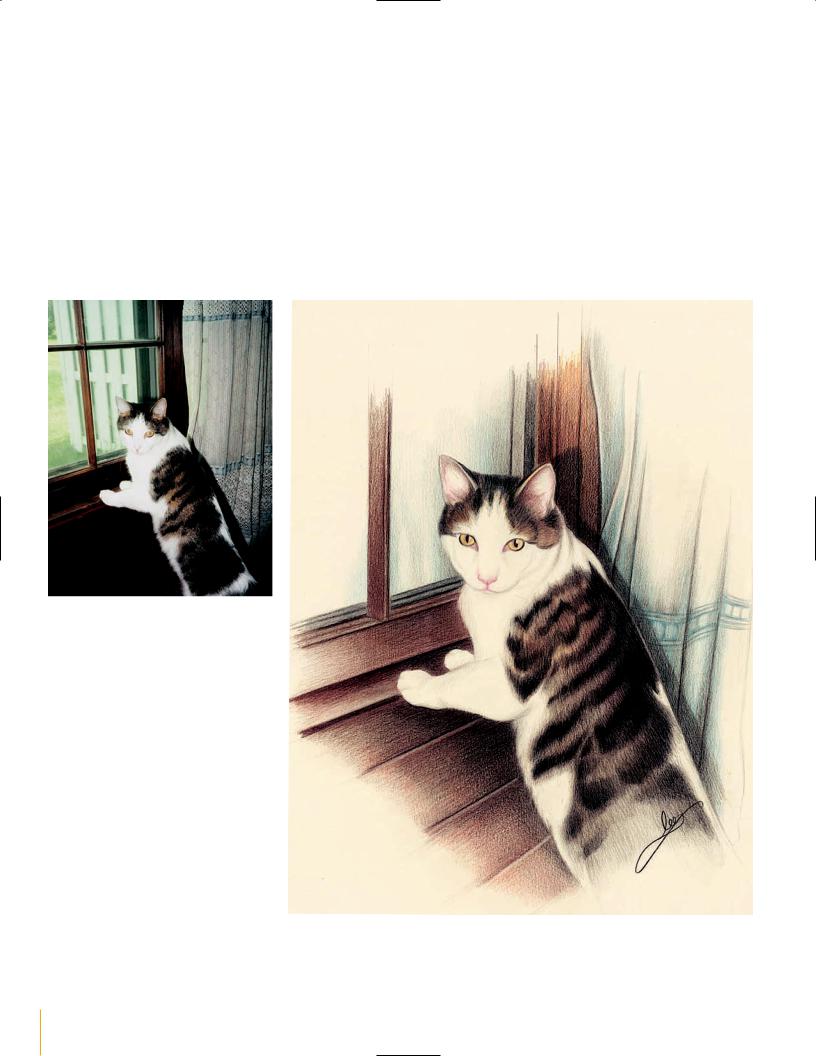
Nothing is more fun for me, as an artist, than turning an ordinary snapshot into a memorable piece of art. I use my camera and my artwork as a way of documenting my life and remembering special things.
Illustration is the art of telling a story through pictures. This drawing
takes my snapshot and turns it into something more meaningful. While drawing this piece, I was immediately transported back to that moment in time, remembering everything as I experienced it. Artwork is magical that way. The finished product is more than a drawing, it is a memory.
Note: During the writing of this book my cat, Meowser, unfortunately died due to illness. Now these illustrations are more meaningful to me than ever.
AN ORDINARY SNAPSHOT CAN BECOME INTERESTING ARTWORK
This is a snapshot I took of Meowser. It isn’t that good of a picture, but the story behind it is cute. All kitties like to look out the window, and mine is no exception. This time there was a bird outside, and Meowser watched it for quite a while. Of course, as soon as I grabbed the camera he had to look at me instead.
MEOWSER LOOKING OUT THE WINDOW
Verithin pencils on no. 2259 Antique White mat board 12" x 9" (31cm × 23cm)
6Drawing in Color: Animals
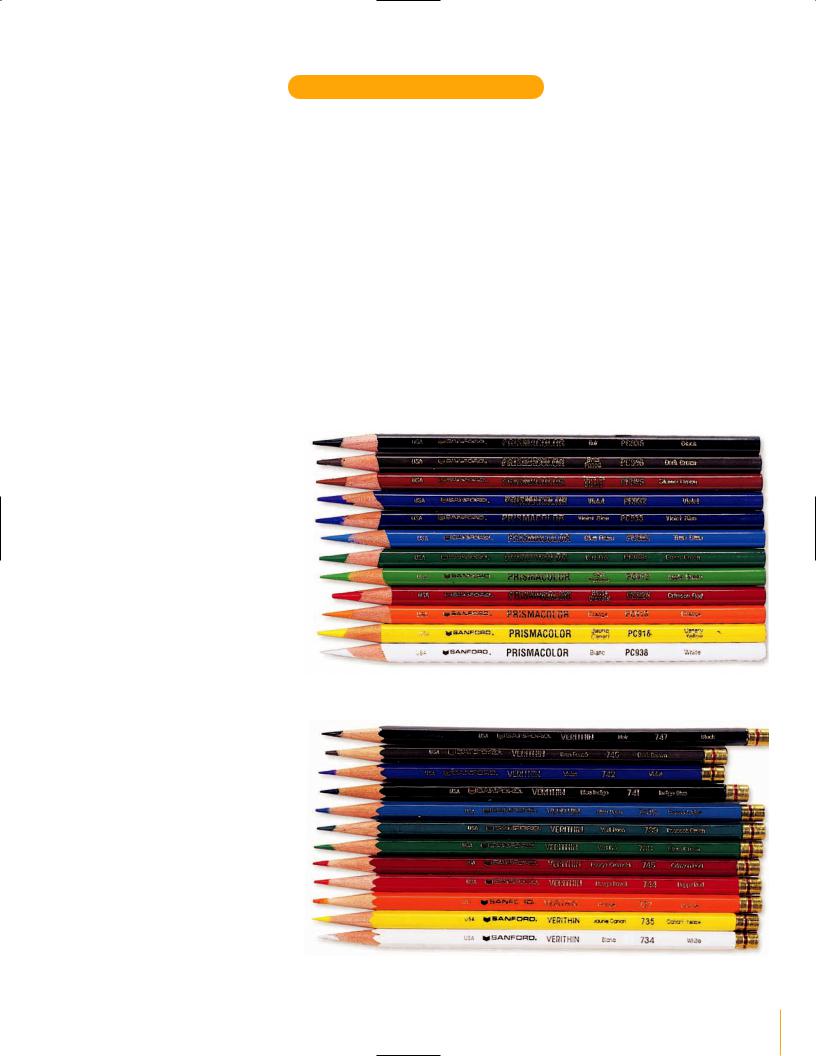
C h a p t e r T w o
Getting Started
Using the Proper Pencils
Each brand of colored pencil has a different appearance when used. Each pencil is made differently to create an unique effect. I can’t easily answer which pencil is “the best,” or which one I like the most. It really depends on the final outcome and the “look” I want my work to have. Rarely will I use just one brand of pencil to complete a project. Any one of them alone is somewhat limited. I have found that by using a combination of pencils, I can create more variety in my techniques. This enables me to achieve the look I’m trying to accomplish. The following is an overview of the four types of pencils I like the most.
PRISMACOLOR PENCILS
Prismacolors have a thick, soft waxbased lead that provides a heavy application of color. They are opaque and will completely cover the paper surface. They are excellent for achieving smooth, shiny surfaces and brilliant colors. The colors can be easily blended to produce an almost “painted” appearance to your work. They come in a huge selection of colors: 120 or more.
ened to a very fine point. They are compatible with Prismacolor but are more limited in their color range, which is thirty-six. I use Verithins whenever I want the paper to show through because they cannot build up to a heavy coverage. They can give you
Prismacolor pencils
VERITHIN PENCILS
Verithins also have wax-based lead, but have a harder, thinner lead than Prismacolors. Because of their less
waxy consistency, they can be sharp-
Verithin pencils
very sharp, crisp lines. Verithins are good for layering colors without the colors mixing together. Prismacolors can give your work a painted appearance; Verithins give your work more of a “drawn” look.
Getting Started |
7 |
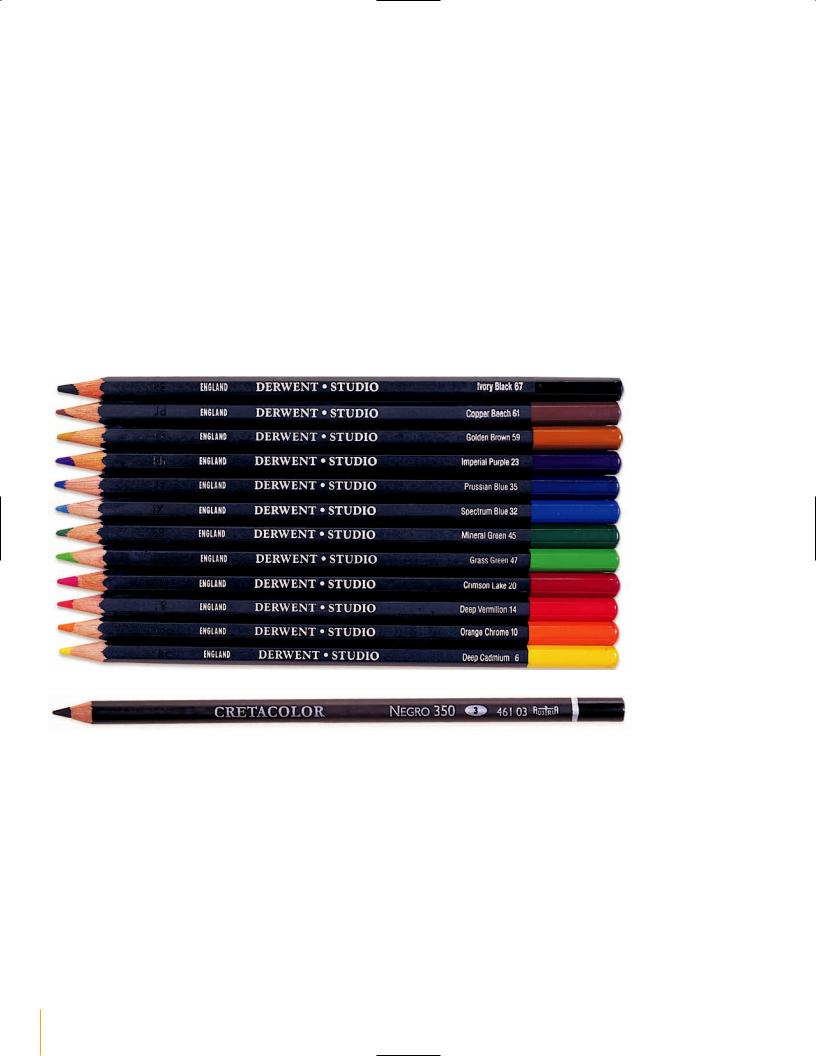
STUDIO PENCILS
Studio pencils, by Derwent, are somewhat like a composite of the other brands. They are a clay-based pencil with a range of seventy-two colors. Applied heavily, they can create deep, dark hues. Applied lightly, they can be blended with a tortillion (see page 10). They also have a sister pencil called the Artists line, which is the same formulation with a bigger
lead diameter. I use the Studio line because I prefer a sharper point. Also, because it is clay based, it will not build up color as well as Prismacolor and will give more of a matte (nonglossy) finish.
NEGRO PENCILS
Using the Negro clay-based black pencil is an excellent way to achieve deep, rich black in your work with-
out a hazy wax buildup. This is the blackest pigment I’ve ever found in a colored pencil. It comes in five degrees of hardness, ranging from soft (1) to hard (5).
Studio pencils.
Negro pencils.
8Drawing in Color: Animals
